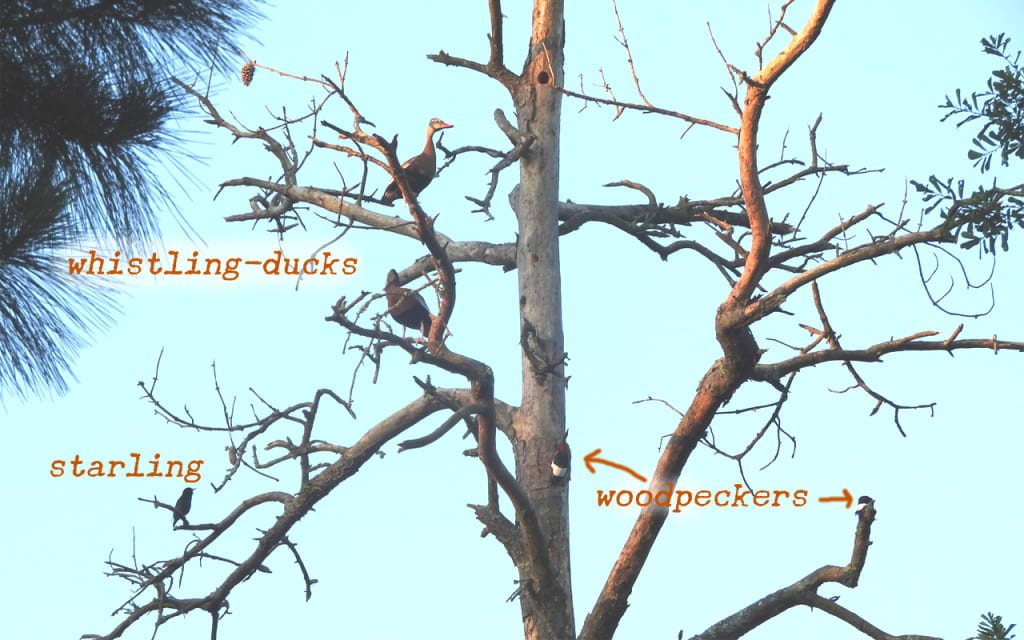Neighbors Are Quiet Drama
A tale of two Whistling-Ducks, a Starling family, and a Red-Headed Woodpecker

Spring 2021
A couple of Black-Bellied Whistling-Ducks have been visiting the dead tree a bit after sunrise each morning. It’s the tree the Red-Bellied Woodpeckers nested in earlier in the season, but now they’ve finished, and a pair of European Starlings has claimed one of the cavities. As I study it over the first cup of wake-up coffee, I observe a small drama that reminds me of the delicate dance we do when deciding how to handle difficult neighbors.
The Starling has fetched a large, leggy insect or perhaps a small lizard. I can’t quite tell at this distance. Bird would like to serve it up to its mate on the nest, but one of the Whistling-Ducks is sitting near the hole.
Starling perches and regards the Whistling-Duck. Won’t you please move, good buddy?
Socially clueless Whistling-Duck regards the Starling. I’m not doing anything. I’m just hanging out while my mate and I catch a few rays.
I’ve imagined the unspoken conversation. Perhaps that’s what they mean to say, and perhaps it isn’t. In any event, the Starling isn’t afraid of the much larger Whistling-Duck. The Starling is merely annoyed.

After a minute or two, Starling hops past Whistling-Duck to feed breakfast to its mate waiting inside the nest cavity. Once finished, once its bill is free, you might think Starling would give Whistling-Duck a warning nip to the back of the head. Starling doesn’t bother.
Neighbors. Can’t live with them, can’t hit them on the head.
Another minute or two. Suddenly, I notice the Red-Headed Woodpecker moving quietly along a branch. When did it fly in?
The Red-Heads know this tree. In 2020, they nested here. This year, they nested nearby. Earlier in the year, they scuffled a bit with the Red-Bellies who claimed it because they got started much earlier.
Today, the Red-Head is creeping along quietly. Sneaking, you could say. Loitering with intent.
Down that dead branch and onto the main trunk and up toward the line of cavities. Is the Starling nest at risk? I wonder. Starlings and Red-Headed Woodpeckers are famous enemies — but usually because the Starling has taken the Red-Heads’ cavity and not the other way round.

But there are always exceptions. Red-Heads are far more successful in my southeast Louisiana neighborhood than Starlings. This Red-Head certainly seems to be creeping its way up to… something.
And then the Red-Head sees the Whistling-Ducks, standing there, two clueless sentinels just outside the door. They are no real threat and rarely spend more than an hour in this spot in the morning, but the Red-Head has seen enough. It flies away. Ends up a few minutes later at my feeder.
And now I have a different view of the Starling’s hesitation. Starlings aren’t shy or afraid of a good scuffle. In fact, to a lot of North Americans, they’re classed as bullies. Bird didn’t appear to particularly appreciate the large Whistling-Duck sitting so close to its cavity. Bird might have engaged.
Only — maybe — a big stomping Whistling-Duck is a quiet discouragement to a foraging Red-Head. Only — maybe — Starling thought ahead. Calculated the pros and cons. Decided what the heck. Whistling-Duck could stay.
Or so I theorize.
In any case, the Whistling-Ducks continue to bask in the morning sun, but they won’t sit here much longer. Not with their many friends whistling to them, flying back and forth, getting busy with their day.
Starling doesn’t wait for Whistling-Ducks to leave. Confident all is right with the world, the bird picks a nearby perch and begins to sing.
A few weeks later in late May
Beep, beep, beep. The last song the old dead pine will ever hear is the sound of the tree removal truck.
The needles turned red in death. Bark beetle, I presume. And then late October 2020’s Hurricane Zeta blew away the needles.
In the pine’s afterlife, it gave a home to cavity-nesting birds like Red-Headed Woodpecker, Red-Bellied Woodpecker, and European Starling. Its height made it a useful perch for Cooper’s Hawk and Black-Bellied Whistling-Duck.
For a few days before the end, a young Red-Headed Woodpecker — its head not yet completely red — would sit near the top. Its hoarse call could be heard all over the neighborhood. The parents had already stopped feeding, though, and eventually the bird flew off on its own.
A hole now where a home used to be. An empty space in my skyline.
And yet the old tree surely had to go. It was very tall and very visibly dead, and houses are close in southeast Louisiana neighborhoods, and hurricane season begins again on June 1.
And the Starlings? I saw them once, a while ago now, adults and a couple of fledged young hopping in the recently mown grass of my back lawn. Then they were gone.
In the mornings, the Whistling-Ducks fly low, talking to each other. I wonder if they are looking for their sunrise perch.
If you enjoyed my story and photograph, I'd be thrilled if you gently tapped that <3 button. Tips always gratefully accepted.
About the Creator
Amethyst Qu
Seeker, traveler, birder, crystal collector, photographer. I sometimes visit the mysterious side of life. Author of "The Moldavite Message" and "Crystal Magick, Meditation, and Manifestation."
https://linktr.ee/amethystqu






Comments
There are no comments for this story
Be the first to respond and start the conversation.